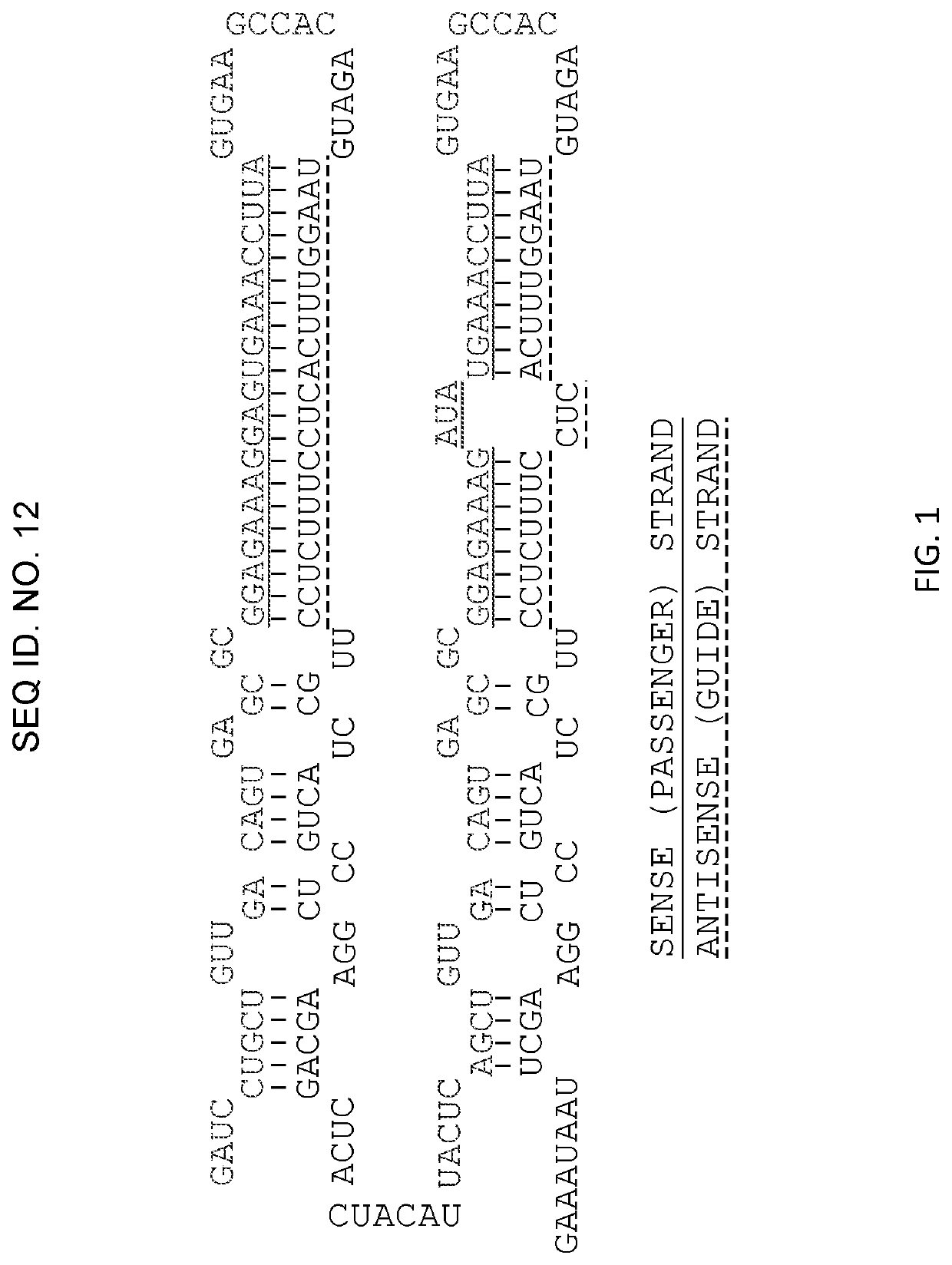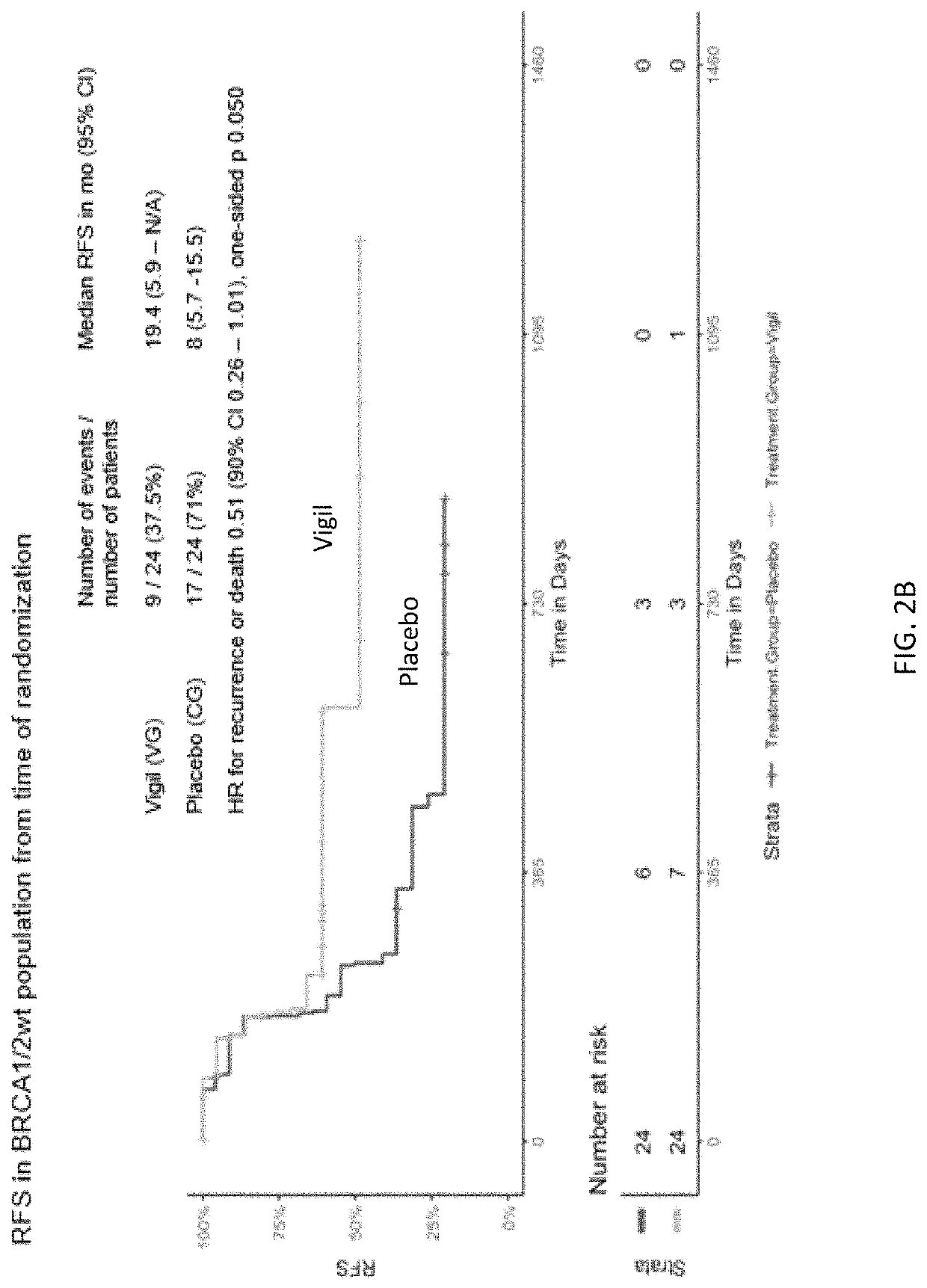Methods for treating cancers
a cancer and cancer technology, applied in the field of cancer treatment methods, can solve the problems of high mortality and the rate of ovarian cancer recurrence, high lethality, and frequent recurrence of ovarian cancer
- Summary
- Abstract
- Description
- Claims
- Application Information
AI Technical Summary
Benefits of technology
Problems solved by technology
Method used
Image
Examples
example 1
ild Type Frontline Stage III / IV Ovarian Cancer Recurrence Free and Overall Survival Advantage Using Vigil®
[0291]Given the limitations of frontline treatment for advanced ovarian cancer, relationship of high TGFβ expression to immune inhibition in ovarian cancer, and limited treatment options in BRCA1 / 2-wt patients, a study was initiated to examine the use of Vigil® as frontline maintenance therapy in patients with ovarian cancer.
Materials and Methods
Trial Design and Treatments
[0292]This Phase 2b, double-blind trial of Vigil® vs. placebo involved 25 sites. Patients with Stage III / IV high-grade serous ovarian cancer in clinical complete response (cCR) following combination of surgery and chemotherapy involving carboplatin and paclitaxel were included. Patients enrolled could have either primary debulking surgery followed by adjuvant chemotherapy or neoadjuvant chemotherapy followed by interval debulking surgery and adjuvant chemotherapy. Germline and / or somatic BRCA1 / 2 molecular profi...
example 2
Principle Study of Sequential Combination Atezolizumab and Vigil® in Relapsed Ovarian Cancer
[0328]Despite impressive evidence of immune modulatory advantage to checkpoint inhibitor (CI) therapy in many cancer types, little advantage has been shown in OC. Theories point to this inefficiency being likely due to lack of specificity of CI combined with significant heterogenicity and genetic instability in OC. Recent reports detail how ovarian cancer (OC) cells can acquire potential escape mechanisms to evade host immunity via several immunosuppressive factors, including a loss of MHC expression and the upregulation of immunosuppressive factors including TGF-beta (TGFβ), indoleamine 2,3-dioxygenase (IDO) and cyclooxygenase (COX-1 and COX-2).
[0329]Vigil® is an autologous tumor cell vaccine in which tumor cells are harvested from patients at the time of debulking surgery and transfected via electroporation extracorporeally with a plasmid encoding for the GMCSF gene, an immune-stimulatory c...
example 3
ild Type Frontline Stage III / IV Ovarian Cancer Relapse Free Survival Advantage Using Vigil®
[0351]Given limits of frontline treatment options for advanced ovarian cancer, particularly in high TGFβ expressive ovarian cancer and involving the BRCA1 / 2-wt population (85% of ovarian cancer patients), a double-blind, placebo-controlled study of Vigil® as frontline maintenance therapy in ovarian cancer patients with Stage III / IV disease following debulking surgery and combination paclitaxel and carboplatin was carried out.
[0352]1. Materials and Methods
[0353]Trial Design and Treatments
[0354]This Phase lib, double-blind trial was conducted at 25 sites. This was a placebo-controlled trial of Vigil® in patients with Stage IIIa-c or IV high-grade serous, clear cell, or endometrioid ovarian cancer in clinical complete response (cCR) following surgery and consolidation chemotherapy (5-8 cycles) involving carboplatin and paclitaxel, as classified level 1 category, NCCN guidelines (Version 3.2015). ...
PUM
| Property | Measurement | Unit |
|---|---|---|
| time | aaaaa | aaaaa |
| time | aaaaa | aaaaa |
| time | aaaaa | aaaaa |
Abstract
Description
Claims
Application Information
 Login to View More
Login to View More - R&D
- Intellectual Property
- Life Sciences
- Materials
- Tech Scout
- Unparalleled Data Quality
- Higher Quality Content
- 60% Fewer Hallucinations
Browse by: Latest US Patents, China's latest patents, Technical Efficacy Thesaurus, Application Domain, Technology Topic, Popular Technical Reports.
© 2025 PatSnap. All rights reserved.Legal|Privacy policy|Modern Slavery Act Transparency Statement|Sitemap|About US| Contact US: help@patsnap.com



